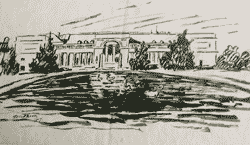In Paris Beer is a member of the “Montparnasse band”, some hundred international artists who expose regularly at the Café Rotonde (the association Les Amis de Montparnasse). If there certainly were several Scandinavians present around Beer, many others were French as Frédéric Deshays, Clément and Dunoyer de Segonzac, Spanish as Gonzalez or American as Cullen.
Among these friends were also Amedeo Modigliani who died in 1920, sick and miserable. One year before, the Italian made a pencil portrait of his Swedish pal. In his turn, Dick Beer portrayed the sculptor Frédéric de Fréminville, a loyal fellow bohemian (we have not been able to retrace the life of this man nicknamed ”the small count”, but an aquarellist with the same name is represented at the museum of St Brieuc). Another great friend was the Chilean painter Manuel Ortiz de Zarate (who was close both to Picasso and Modigliani), represented at the Museum of Contemporary Art of Santiago de Chili with the outstanding portrait of Chela Aranis. Co-founder of the Groupe de Montparnasse in 1923, Ortiz lived in Paris until his death in 1946.

The Sicilian painter Gabriele Pietro Varese had common interests with Beer in horse painting, they were intimate and the two were seen together many times at Chantilly and other races. During twenty years Varese presided the association of Italian painters in France and in 1919 Beer made a cubist portrait of him. The French artist of Russian origin Léopold Survage was another companion. In 1929, at the least, the two met extensively. Survage had Danish-Finn parents, grow attached to cubism thanks to Appolinaire and shared with Beer an interest for music and opera (in 1922 he created the sets for Mavra, Diagilev’s ballet). The Swede was frequently seen disputing chess games with the sculptor Henri Laurens. The important Swedish cubist, art theoretician and critic Otto G. Carlsund spent much time with Beer in Sweden during the thirties and made the layout for the catalogue of the 1942 commemorative exhibition. In Paris they saw less of each other as Carlsund had integrated another artistic circle, more abstractaround Fernand Léger.
This is how Otto G. Carlsund saw his colleague’s art in 1932:
“Dick Beer has been living in Paris for twenty years. One would believe that his art for this reason is eminently French. This is not the case. Not the colours in the way he combines them, nor the treatment of his models’ skin, nor the lighting approach or the manner to handle the brush seem to us particularly French. (…) His pictures don’t try to complicate things. In them we don’t find confrontations nor affectations, nothing which may trouble quite a perfect harmony.”
Let’s say that Beer may be very Swedish, as he is very French (compared to most Swedish artists), or simply very « Entre-deux-guerres ». What we should remark is that according to periods, travels and moods, his canvases vary considerably (in style, in techniques), as if he were himself unable to determine his cultural identity. Dick Beer is a “Nordic wog”, one would have remarked in Paris’ bohemian bars of the time. Eclectic it may be but it is not difficult for a trained eye to grasp the artistic continuity. In subjects chosen he is also surprisingly constant: landscapes, nudes, horses…
Among the Swedish artists of the epoch, it is natural that Dick Beer was acquainted with some of the most significant. At the Academy of Fine Arts in Stockholm he is the companion of Hilding Linnqvist, Emil Olsson and Siri Derkert (the latter remained a friend of the family with the future husband Evert Taube, Sweden’s most important popular composer). From 1912 in Paris, Beer has « his » group with Swedish colleagues : Eric Detthow and Bertil Bull Hedlund among the painters ; the sculptors Ragnar Gellerstedt, Eric Grate and Carl Frisendahl.
Bull Hedlund, specifically recognized as one of Sweden’s most important book illustrators, had the same age as Dick Beer and remained his great friend for the lifetime. The two take on cubism together and exhibit at Liljewalchs in 1919.
There were not only plastic artists seeking the friendship of Dick Beer. In 1928, for instance, he sees the great Danish poet Sophus Claussen almost on a daily basis, discussing metaphysical issues. Another year he spends much time with the female writer Ulla Bjerne from Sweden. The famous singer Fjodor Sjaljapin was a steady friend in Paris’ Russian colony.
Without being an active contributor to Swedish intellectual life, Dick Beer portrayed the big literary names of the time, such as Wilhelm Moberg, Eyvind Johnson, Carl Sam Åsberg and Ture Nerman (the latter a personal friend). In 1927 he paints the politician and trade unionist Z. Höglund (“the only Marxist in Sweden” according to Lenin).
(Continued)